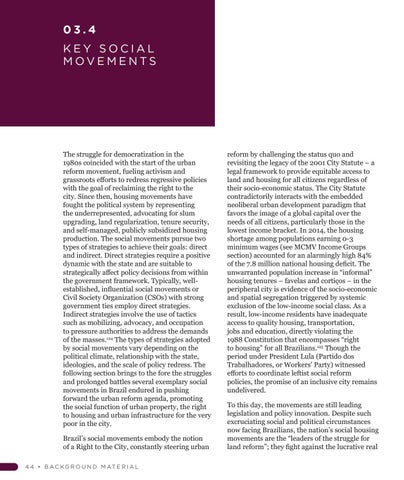03.4 KEY SOCIAL MOVEMENTS
The struggle for democratization in the 1980s coincided with the start of the urban reform movement, fueling activism and grassroots efforts to redress regressive policies with the goal of reclaiming the right to the city. Since then, housing movements have fought the political system by representing the underrepresented, advocating for slum upgrading, land regularization, tenure security, and self-managed, publicly subsidized housing production. The social movements pursue two types of strategies to achieve their goals: direct and indirect. Direct strategies require a positive dynamic with the state and are suitable to strategically affect policy decisions from within the government framework. Typically, wellestablished, influential social movements or Civil Society Organization (CSOs) with strong government ties employ direct strategies. Indirect strategies involve the use of tactics such as mobilizing, advocacy, and occupation to pressure authorities to address the demands of the masses.124 The types of strategies adopted by social movements vary depending on the political climate, relationship with the state, ideologies, and the scale of policy redress. The following section brings to the fore the struggles and prolonged battles several exemplary social movements in Brazil endured in pushing forward the urban reform agenda, promoting the social function of urban property, the right to housing and urban infrastructure for the very poor in the city. Brazil’s social movements embody the notion of a Right to the City, constantly steering urban 4 4 • B A C K G R O U N D M AT E R I A L
reform by challenging the status quo and revisiting the legacy of the 2001 City Statute – a legal framework to provide equitable access to land and housing for all citizens regardless of their socio-economic status. The City Statute contradictorily interacts with the embedded neoliberal urban development paradigm that favors the image of a global capital over the needs of all citizens, particularly those in the lowest income bracket. In 2014, the housing shortage among populations earning 0-3 minimum wages (see MCMV Income Groups section) accounted for an alarmingly high 84% of the 7.8 million national housing deficit. The unwarranted population increase in “informal” housing tenures – favelas and cortiços – in the peripheral city is evidence of the socio-economic and spatial segregation triggered by systemic exclusion of the low-income social class. As a result, low-income residents have inadequate access to quality housing, transportation, jobs and education, directly violating the 1988 Constitution that encompasses “right to housing” for all Brazilians.125 Though the period under President Lula (Partido dos Trabalhadores, or Workers’ Party) witnessed efforts to coordinate leftist social reform policies, the promise of an inclusive city remains undelivered. To this day, the movements are still leading legislation and policy innovation. Despite such excruciating social and political circumstances now facing Brazilians, the nation’s social housing movements are the “leaders of the struggle for land reform”; they fight against the lucrative real













